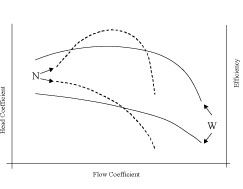Compressor range vs. efficiency, an introduction
Below are excerpts from the paper titled, 'Range versus efficiency – striking the proper balance ' presented by James M. Sorokes at the 44th Turbomachinery and 31st Pump Symposia Houston, Texas in September 2015.
Two of the most important considerations in centrifugal compressor performance are efficiency and overall flow or operating range. A compressor’s efficiency has a direct impact on the power requirement for the process because higher efficiency yields lower power consumption or allows more product to be made for a given amount of energy input. The overall flow range limits the compressor’s ability to operate at other than the design condition; i.e. off-design conditions. Ideally, compression equipment would provide both high peak efficiency and wide overall operating range.
Unfortunately, efficiency and flow range are quite often mutually opposing forces in the real world. The very features that contribute to high peak efficiency (i.e. vaned diffusers) can and do cause a reduction in overall operating range. Likewise, the design approaches used to obtain wide operating flow range typically do not provide the maximum achievable peak efficiency levels. As a result, the designer must determine the proper balance between overall flow range and peak efficiency when developing new stages and/or specifying components for a compressor application.

It might be possible to maximize both range and efficiency but only via non-standard components that add to the complexity and, therefore, the cost of the equipment. However, in some applications, the additional range provided might justify the added expense. For example, if by providing additional range, a bundle change-out can be avoided, the additional upfront cost of the compressor might be offset by the reduction in long-term costs that would result from the bundle changes, production interruptions, and other related expenses.
The cost to build the compressor and/or other manufacturing concerns/limitations strongly influence the design choices made by OEMs and said choices can have significant impact on equipment performance. The impact on the design philosophy for impellers, diffusers, guide vanes and other components is discussed. For example, it is common knowledge that channel vaned diffuser (i.e. wedge diffusers) provide high peak efficiencies but at the expense of overall flow range. However, it is less commonly known that good flow range is possible with a wedge diffuser if the upstream impeller is designed to promote this. Also, in the past 20 years, various styles of alternate vaned diffusers have been developed that do not impact flow range assuming the upstream impeller provides a reasonable exit flow profile.
Choices must be made with regard to the operating requirements for a compressor with regard to the trade-off of peak efficiency and overall operating range. Compressor applications tend to fall between two operational extremes. At one extreme are compressors that operate over a 5% of the design flow rate;±very narrow flow range; i.e. within and at nearly constant speed (excluding start-up and shutdown). Two examples are gas generator sections of gas turbines and compressors that supply air for manufacturing facilities.
To facilitate the discussion, these compressors will be referred to as Type “N” for narrow range. Since the Type “N” compressor operates over a very narrow flow range, it is possible to optimize its performance for that very specific flow rate. Very high peak efficiencies are possible but as Type “N” compressors operate further from design flow, the efficiency drops off very rapidly. The curve labeled “N” in Figure 1 is somewhat typical for such a compressor.
At the opposite extreme are compressors that must operate 30% of design flow. The ± over a very wide flow range; i.e., wide flow range requirement may be due to a variety of circumstances; such as:
- Non-uniform inlet or exit conditions; i.e., varying inlet or discharge pressure or temperature,
- Changes in gas compositions,
- Mandated changes in flow rate during certain time periods (i.e., summer and winter conditions for pipeline boosters, peak demand for LNG or other hydrocarbon processing, etc.)
These compressors are designated as Type “W” for wide range. Examples of such applications are pipeline boosters, compressors in hydrocarbon processing plants, and gas reinjection compressors.
Clearly, performance curve “N” in Figure 1 is not going to be acceptable for applications requiring wide range. Therefore, different stages or stage components must be developed for Type “W” compressor applications. These stages must maintain an acceptable level of performance as flow deviates from design. This broader or “flatter” efficiency requirement limits the attainable efficiency at the design condition because components can no longer be optimized for one condition but must operate effectively at many flow rates.
There are also numerous types of impeller (i.e., high Mach number designs) or diffuser designs (i.e., channel or wedge style diffusers) that are not capable of providing optimal performance over a wide flow range. In short, a requirement for very wide flow range results in design choices that will provide a reduction in peak attainable efficiency.
Most compressor applications fall somewhere between Types “N” and “W”. The end-user and OEM must understand what the operating requirements will be for any new compressor or compressor components. They also must recognize the compromise in peak attainable efficiency level that comes with an increased range requirement or the reduction in flow range that will result when pressing for higher efficiency levels. A proper and realistic balance of range and efficiency must be agreed upon before any new compressor or compressor components can be developed or purchased.